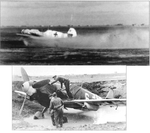Shortround6
Lieutenant General
I think that what type of surface the 109 (and just about all fighters of the mid 30s) were designed to operate from can be guessed at by looking at the airfields that were common or in use during the mid to late 30s. While taxiways or aprons in front of the hangers/terminals were paved the actual "flying field" usually wasn't. The major commercial airports of many European nations used grass surfaces for take-off and landing and in some cases the 'field' was nearly circular so that the planes could almost always take-off and land into the wind.
with even the Tempelhof airport at Berlin having a grass flying surface I doubt that regular fighter fields had paved flying surfaces at the time.
However they may be a vast difference between a carefully graded, prepared, and maintained grass surfaced air field of the late 1930s and hastily prepared front line airstrips in combat zones. Think of the difference between a carefully tended Golf course fairway and a farmers wheat field. They both can loosely be considered "grass".
with even the Tempelhof airport at Berlin having a grass flying surface I doubt that regular fighter fields had paved flying surfaces at the time.
However they may be a vast difference between a carefully graded, prepared, and maintained grass surfaced air field of the late 1930s and hastily prepared front line airstrips in combat zones. Think of the difference between a carefully tended Golf course fairway and a farmers wheat field. They both can loosely be considered "grass".


![6_Squadron_RAAF_Lockheed_Hudson_at_Milne_Bay_Sept_or_Oct_1942[1].jpg](/forum/data/attachments/155/155214-217a2dc79b041b217417175298fbe0a3.jpg)